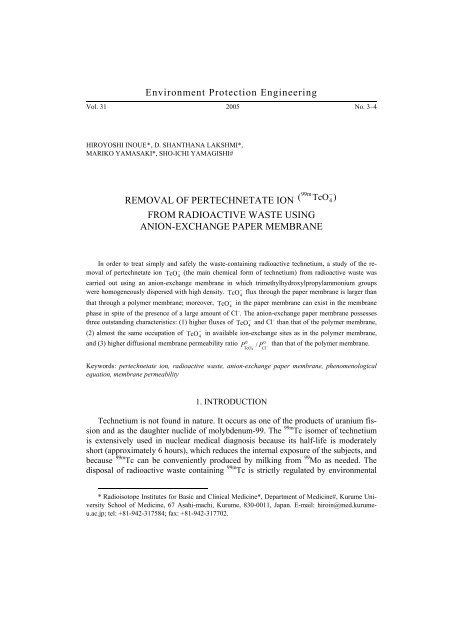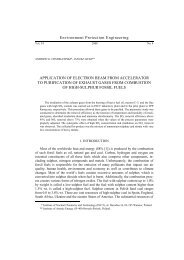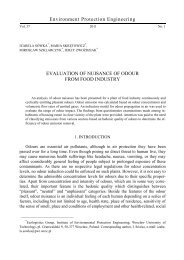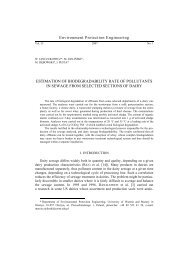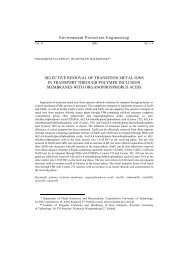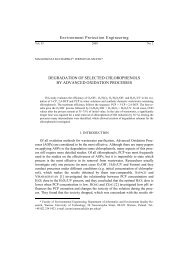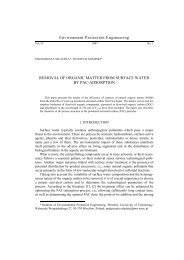Removal of pertechnetate ion from radioactive waste using anion ...
Removal of pertechnetate ion from radioactive waste using anion ...
Removal of pertechnetate ion from radioactive waste using anion ...
You also want an ePaper? Increase the reach of your titles
YUMPU automatically turns print PDFs into web optimized ePapers that Google loves.
Environment Protect<strong>ion</strong> Engineering<br />
Vol. 31 2005 No. 3–4<br />
HIROYOSHI INOUE*, D. SHANTHANA LAKSHMI*,<br />
MARIKO YAMASAKI*, SHO-ICHI YAMAGISHI#<br />
99m −<br />
REMOVAL OF PERTECHNETATE ION ( TcO4<br />
)<br />
FROM RADIOACTIVE WASTE USING<br />
ANION-EXCHANGE PAPER MEMBRANE<br />
In order to treat simply and safely the <strong>waste</strong>-containing <strong>radioactive</strong> technetium, a study <strong>of</strong> the re-<br />
−<br />
moval <strong>of</strong> <strong>pertechnetate</strong> <strong>ion</strong> TcO (the main chemical form <strong>of</strong> technetium) <strong>from</strong> <strong>radioactive</strong> <strong>waste</strong> was<br />
4<br />
carried out <strong>using</strong> an an<strong>ion</strong>-exchange membrane in which trimethylhydroxylpropylammonium groups<br />
−<br />
were homogeneously dispersed with high density. TcO flux through the paper membrane is larger than<br />
4<br />
−<br />
that through a polymer membrane; moreover, TcO in the paper membrane can exist in the membrane<br />
4<br />
phase in spite <strong>of</strong> the presence <strong>of</strong> a large amount <strong>of</strong> Cl<br />
−<br />
4<br />
−<br />
4<br />
0 0<br />
P<br />
– . The an<strong>ion</strong>-exchange paper membrane possesses<br />
three outstanding characteristics: (1) higher fluxes <strong>of</strong> TcO and Cl – than that <strong>of</strong> the polymer membrane,<br />
(2) almost the same occupat<strong>ion</strong> <strong>of</strong> TcO in available <strong>ion</strong>-exchange sites as in the polymer membrane,<br />
and (3) higher diffus<strong>ion</strong>al membrane permeability ratio P than that <strong>of</strong> the polymer membrane.<br />
TcO Cl / − −<br />
4<br />
Keywords: <strong>pertechnetate</strong> <strong>ion</strong>, <strong>radioactive</strong> <strong>waste</strong>, an<strong>ion</strong>-exchange paper membrane, phenomenological<br />
equat<strong>ion</strong>, membrane permeability<br />
1. INTRODUCTION<br />
Technetium is not found in nature. It occurs as one <strong>of</strong> the products <strong>of</strong> uranium fiss<strong>ion</strong><br />
and as the daughter nuclide <strong>of</strong> molybdenum-99. The 99m Tc isomer <strong>of</strong> technetium<br />
is extensively used in nuclear medical diagnosis because its half-life is moderately<br />
short (approximately 6 hours), which reduces the internal exposure <strong>of</strong> the subjects, and<br />
because 99m Tc can be conveniently produced by milking <strong>from</strong> 99 Mo as needed. The<br />
disposal <strong>of</strong> <strong>radioactive</strong> <strong>waste</strong> containing 99m Tc is strictly regulated by environmental<br />
* Radioisotope Institutes for Basic and Clinical Medicine*, Department <strong>of</strong> Medicine#, Kurume University<br />
School <strong>of</strong> Medicine, 67 Asahi-machi, Kurume, 830-0011, Japan. E-mail: hiroin@med.kurumeu.ac.jp;<br />
tel: +81-942-317584; fax: +81-942-317702.
120<br />
H. INOUE et al.<br />
laws; nevertheless, 99m Tc excreted by patients injected with nuclear medicines has<br />
been detected in sludge and in supernatant liquid <strong>from</strong> processing pool in the Kurume<br />
Central Sewage Treatment Plant in Japan [1]. When technetium is released to the envi-<br />
−<br />
ronment, <strong>pertechnetate</strong> <strong>ion</strong> ( TcO4<br />
), the main chemical form <strong>of</strong> technetium, may be<br />
readily absorbed in the human body through agricultural products.<br />
We have already developed the method for concentrating the <strong>waste</strong> containing <strong>radioactive</strong><br />
iodine by means <strong>of</strong> an an<strong>ion</strong>-exchange paper membrane. The process has<br />
a compact apparatus design with no large reservoir [2], and the used paper membrane<br />
can be safely incinerated. We have also shown that removal <strong>of</strong> <strong>radioactive</strong> iodine <strong>from</strong><br />
<strong>waste</strong> <strong>using</strong> an an<strong>ion</strong>-exchange paper membrane is not influenced by electroneutral<br />
substances such as glucose or urea [3]. It has been found that the introduct<strong>ion</strong> <strong>of</strong><br />
trimethylhydroxypropylammonium group into the cellulose fibers improves <strong>radioactive</strong><br />
iodine diffus<strong>ion</strong> within the paper membrane and that the introduct<strong>ion</strong> <strong>of</strong> quaternary<br />
diethylaminoethyl groups improves the <strong>radioactive</strong> iodine solut<strong>ion</strong>/membrane<br />
distribut<strong>ion</strong> process [4]. In addit<strong>ion</strong>, the ratio <strong>of</strong> the electroconductive membrane permeability<br />
to <strong>radioactive</strong> iodine to that to <strong>radioactive</strong> chloride has been shown to be as<br />
high as 6.2 for an an<strong>ion</strong>-exchange paper membrane containing trimethylhydroxypropylammonium<br />
groups [5].<br />
In the present study, we systematically analyze the flux and the behaviour <strong>of</strong><br />
membrane-phase pertechnate <strong>ion</strong>s occurring in trace amounts in the condit<strong>ion</strong>s <strong>of</strong> large<br />
amounts <strong>of</strong> chloride <strong>ion</strong>s (present in actual <strong>radioactive</strong> <strong>waste</strong>) <strong>using</strong> the an<strong>ion</strong>exchange<br />
paper membrane method. The results were compared with those for an an<strong>ion</strong>-exchange<br />
polymer membrane. Membrane transport analyses were carried out <strong>using</strong><br />
the linear phenomenological equat<strong>ion</strong>s being based on nonequilibrium thermodynamics.<br />
2. METHODS<br />
Introduct<strong>ion</strong> <strong>of</strong> trimethylhydroxypropylammonium an<strong>ion</strong>-exchange groups into cellulose<br />
fiber was carried out according to methods previously described [4], [5]. At first,<br />
the prepared cellulose fiber was refined to make their surfaces rough for better bonding.<br />
The paper membrane was then formed <strong>from</strong> a diluted fiber slurry, allowing the water to<br />
drain through a nylon net (100 mesh). The paper membrane was placed between unwoven<br />
clothes and pressed with a heated rolling pin to remove surplus water. Remaining<br />
free water was liberated by heating the membrane on a hot plate at 60 °C. The <strong>ion</strong>exchange<br />
capacity <strong>of</strong> the prepared paper membrane was measured by standard methods.<br />
A univalent selective an<strong>ion</strong>-exchange polymer membrane, NEOSEPTA® AM-1, donated<br />
by Astom Corporat<strong>ion</strong>, Japan, was used in the present study as a reference membrane.<br />
The table summarizes the thickness, the <strong>ion</strong>-exchange capacities, and the water<br />
contents in the paper membrane and the polymer membrane.
<strong>Removal</strong> <strong>of</strong> pertechnatate <strong>ion</strong> 121<br />
Basic properties <strong>of</strong> paper membrane and polymer membrane<br />
Properties Paper membrane Polymer membrane<br />
Thickness 0.19 mm 0.12 mm<br />
Table<br />
Ion-exchange capacity 0.30 meq. g –1 dry memb. 1.6 meq. g –1 dry memb.<br />
Water content * 161 0.36<br />
* Water content is given by (H w – H d)/H d, where H w is the weight <strong>of</strong> the wet membrane and H d is<br />
the weight <strong>of</strong> the completely dry membrane.<br />
The measurements <strong>of</strong> the <strong>ion</strong> flux and <strong>ion</strong> concentrat<strong>ion</strong> within membrane phase<br />
were carried out <strong>using</strong> the system shown in figure 1.<br />
Phase I Membrane phase Phase II<br />
−<br />
TcO : 10–50 kBq<br />
4<br />
Cl – : 1×10 –3 mol dm –3<br />
(pH 5.5)<br />
An<strong>ion</strong> exchange paper<br />
membrane or polymer<br />
membrane<br />
Conductivity<br />
<strong>of</strong> water<br />
(pH 5.5)<br />
Fig. 1. The system for measurements <strong>of</strong> <strong>ion</strong> flux and <strong>ion</strong> concentrat<strong>ion</strong> in membrane phase<br />
The prepared membrane was placed between the phase I and the phase II <strong>of</strong> aqueous<br />
solut<strong>ion</strong>s. The phase I <strong>of</strong> aqueous solut<strong>ion</strong> was composed <strong>of</strong> and 36 Cl – .<br />
The radioactivity <strong>of</strong> the ranged <strong>from</strong> 10 kBq/cm 3 (5.18×10 –16 mol/cm 3 99m −<br />
TcO4<br />
−<br />
TcO<br />
) to 50<br />
4<br />
kBq/cm 3 (2.59×10 –15 mol/cm 3 ). 1×10 –3 mol dm –3 <strong>of</strong> Na 36 Cl solut<strong>ion</strong> was prepared <strong>from</strong><br />
conductivity water and extra-pure non-<strong>radioactive</strong> NaCl. The phase II <strong>of</strong> aqueous solut<strong>ion</strong><br />
was conductivity water. pH values <strong>of</strong> both phases were adjusted to 5.5 with HCl<br />
and NaOH. All measurements were carried out at 25±0.5 °C, with both solut<strong>ion</strong><br />
phases stirred at 90 rpm in all cases. Each measurement point represents the mean<br />
value (without standard error) <strong>of</strong> five samples.<br />
The and 36 Cl – fluxes were measured by monitoring the radioactivity in<br />
phase II <strong>using</strong> a γ-ray scintillat<strong>ion</strong> counter (Amersham Pharmacia Biotech; 1470 Wizard,<br />
NJ) and a liquid scintillat<strong>ion</strong> counter (Beckman; LS6500, CA), respectively. The<br />
above membrane samples, after having wiped <strong>of</strong>f the adhering radioisotopes with filter<br />
paper, were also <strong>radioactive</strong>ly measured to determine the and 36 Cl – 99m −<br />
TcO4<br />
99m −<br />
TcO4<br />
concentrat<strong>ion</strong><br />
within the membrane phase.
122<br />
H. INOUE et al.<br />
3. RESULTS AND DISCUSSION<br />
−<br />
TcO 4 fluxes through both the paper and polymer membranes were increased with<br />
an increase in the concentrat<strong>ion</strong> <strong>of</strong> the phase I (figure 2A-1), while Cl – fluxes through<br />
both the paper and polymer membranes were not influenced by increasing concentrat<strong>ion</strong><br />
<strong>of</strong> the phase I (figure 2A-2). The net fluxes <strong>of</strong> and Cl – through the<br />
paper membrane were almost by two orders <strong>of</strong> magnitude greater than those through<br />
the polymer membrane as shown in figures 2A-1 and 2A-2. The paper membrane can<br />
absorb about 450 times more water per dry weight than the polymer membrane as<br />
shown in the table. Moreover, the mean pore size <strong>of</strong> the paper membrane ranges approximately<br />
<strong>from</strong> 1 to 5 μm (as estimated <strong>from</strong> micrographical measurements), while<br />
that <strong>of</strong> the polymer membrane is less than 1 nm (as indicated by the manufacturer).<br />
Hydrated radii <strong>of</strong> the permeating <strong>ion</strong>s, and Cl – , are almost equivalent <strong>of</strong> 3.5 Å<br />
and 3.0 Å, respectively [10], [11]. Therefore, and Cl – −<br />
TcO4<br />
−<br />
TcO4<br />
−<br />
TcO4<br />
−<br />
TcO4<br />
<strong>ion</strong>s in the paper membrane<br />
can be transported more freely than those within the polymer membrane as<br />
shown in figures 2A-1 and 2A-2.<br />
100<br />
Flux / 10 10<br />
-<br />
16 -2<br />
mol m<br />
s -1<br />
1<br />
0.1<br />
10<br />
Flux /<br />
10<br />
1<br />
0.1<br />
-6 mol<br />
m -2 s -1<br />
100<br />
C 10<br />
1<br />
m Total /<br />
10 -14 mol<br />
kg -1<br />
TcO4 -<br />
A B<br />
1 1<br />
TcO4 -<br />
Cl -<br />
0.01<br />
0 10 20 30 40 50 60<br />
TcO4 - Radioactivity <strong>of</strong> phase I / kBq<br />
2<br />
0.1<br />
10<br />
C 1<br />
m Total /<br />
mol kg -1<br />
0.1<br />
Cl -<br />
0.01<br />
0 10 20 30 40 50 60<br />
TcO4 - Radioactivity <strong>of</strong> phase I / kBq<br />
Fig. 2. Intercompartment <strong>ion</strong> flux (A) and its concentrat<strong>ion</strong> (mol g –1 -dry membrane)<br />
in membrane phase (B) as a funct<strong>ion</strong> <strong>of</strong> the TcO radioactivity <strong>of</strong> phase I. Upper frames (1)<br />
and lower frames (2) indicate flux and concentrat<strong>ion</strong> <strong>of</strong> TcO and Cl – −<br />
4<br />
− , respectively.<br />
4<br />
Circles and triangles denote paper membrane and polymer membrane, respectively<br />
2
<strong>Removal</strong> <strong>of</strong> pertechnatate <strong>ion</strong> 123<br />
Figures 2B-1 and 2B-2 illustrate the and Cl – TcO4<br />
<strong>ion</strong> concentrat<strong>ion</strong>s within the<br />
−<br />
membrane phase as a funct<strong>ion</strong> <strong>of</strong> the radioactivity <strong>of</strong> TcO4<br />
in the phase I. The total<br />
−<br />
m<br />
amount <strong>of</strong> TcO per unit polymer membrane weight C − ) was 33 to 79 times<br />
4<br />
greater than that per unit weight <strong>of</strong> paper membrane (figure 2B-1). On the other hand,<br />
the total amount <strong>of</strong> Cl – per unit weight <strong>of</strong> paper membrane was constant<br />
and equal to 3.7% <strong>of</strong> the total amount <strong>of</strong> Cl – per unit weight <strong>of</strong> polymer membrane<br />
(figure 2B-2). It was quite usual that a small quantity <strong>of</strong> in the membrane phase<br />
increased, whereas large quantity <strong>of</strong> Cl – in the membrane phase increased with an<br />
increasing amount <strong>of</strong> in the phase I. Although the ratio <strong>of</strong> the external solut<strong>ion</strong><br />
concentrat<strong>ion</strong>s ranged <strong>from</strong> 2×10 –14 to 4×10 –13 m<br />
( C − ) Cl , total<br />
−<br />
TcO4<br />
−<br />
TcO4<br />
external external<br />
(C C )<br />
, the ratio <strong>of</strong> the <strong>ion</strong><br />
TcO 4 −<br />
/ Cl −<br />
m<br />
C −<br />
TcO 4<br />
m<br />
C −<br />
Cl<br />
concentrat<strong>ion</strong>s in the membrane ranged <strong>from</strong> 3.2×10 –13 to 9.4×10 –13 ( / )<br />
for<br />
the paper membrane and <strong>from</strong> 9.6×10 –13 to 1.2×10 –12 for the polymer membrane.<br />
−<br />
TcO4<br />
<strong>ion</strong>s within the paper membrane and the polymer membrane were slightly concentrated.<br />
A concept established on the basis <strong>of</strong> theoretical and experimental investigat<strong>ion</strong>s <strong>of</strong><br />
membrane transport phenomena is that <strong>ion</strong> transport through a charged membrane can<br />
be analyzed as a funct<strong>ion</strong> <strong>of</strong> the solut<strong>ion</strong>/membrane distribut<strong>ion</strong> coefficient <strong>of</strong> permeating<br />
<strong>ion</strong>s and <strong>of</strong> the migrat<strong>ion</strong> speed <strong>of</strong> the <strong>ion</strong>s in the membrane phase [8]. In the<br />
−<br />
present system, the solut<strong>ion</strong>/membrane distribut<strong>ion</strong> <strong>of</strong> TcO4<br />
in the polymer membrane<br />
takes priority over that in the paper membrane. On the other hand, the diffus<strong>ion</strong><br />
−<br />
<strong>of</strong> TcO4<br />
in the paper membrane takes priority over that in the polymer membrane.<br />
It is convenient to make use <strong>of</strong> the membrane permeability analysis in order to<br />
evaluate synthetically the transport <strong>of</strong> and Cl – −<br />
TcO4<br />
through a charged membrane.<br />
The matrix theory <strong>of</strong> the membrane permeability reported by KIMIZUKA et al. [9] has<br />
been shown to be useful for quantitative analysis <strong>of</strong> permselective <strong>ion</strong> transport across<br />
a charged membrane. In the paper-membrane transport process characterized by the<br />
<strong>ion</strong>ic diffus<strong>ion</strong> process (with no membrane current), thermodynamic analyses can be<br />
expressed by:<br />
⎡ J<br />
⎢<br />
⎢J<br />
⎢<br />
⎣<br />
J<br />
Na<br />
TcO<br />
Cl<br />
+<br />
−<br />
⎡ 0 ⎤ PNa<br />
⎥ ⎢<br />
⎥ = −⎢<br />
0<br />
⎥ ⎢<br />
⎦ ⎣<br />
0<br />
−<br />
4<br />
where:<br />
J is the <strong>ion</strong> flux,<br />
+<br />
0<br />
0<br />
TcO<br />
P<br />
0<br />
−<br />
4<br />
−<br />
( , total<br />
TcO 4<br />
⎤⎡<br />
I<br />
0 − a<br />
⎤<br />
+ exp( −FV0<br />
/ 2RT<br />
)<br />
Na ⎥⎢<br />
⎥<br />
I<br />
0 ⎥⎢<br />
− a − exp( FV0<br />
/ 2RT<br />
) ⎥ , (1)<br />
TcO 4<br />
0 ⎥⎢<br />
I<br />
⎥<br />
P − ⎦⎣<br />
− a − exp( FV0<br />
/ 2RT<br />
)<br />
Cl Cl<br />
⎦
124<br />
H. INOUE et al.<br />
P is the diffus<strong>ion</strong>al membrane permeability,<br />
a is the <strong>ion</strong>ic activity,<br />
F is the Faraday constant,<br />
V0 is the membrane potential at zero membrane current,<br />
R is the gas constant,<br />
T is the absolute temperature,<br />
the superscript I indicates the aqueous solut<strong>ion</strong> phase I and the subscripts Na + ,<br />
−<br />
TcO4<br />
, and Cl – refer to co-<strong>ion</strong> Na + and counter-<strong>ion</strong>s and Cl – TcO4<br />
[8].<br />
The following equat<strong>ion</strong> is derived <strong>from</strong> equat<strong>ion</strong> (1):<br />
P 0 TcO4<br />
/ P 0 Cl<br />
100<br />
10<br />
1<br />
0.1<br />
0<br />
TcO<br />
0<br />
−<br />
Cl<br />
P<br />
P<br />
−<br />
4<br />
0 10 20 30 40 50 60<br />
=<br />
J<br />
a<br />
J<br />
TcO<br />
−<br />
4<br />
−<br />
Cl<br />
I<br />
TcO<br />
I<br />
−<br />
Cl<br />
X 10<br />
100<br />
A B<br />
3<br />
X 10 ? 3<br />
a<br />
−<br />
4<br />
10<br />
D m TcO4<br />
/ D m Cl<br />
TcO4 - Radioactivity <strong>of</strong> phase I / kBq<br />
1<br />
−<br />
. (2)<br />
0.1<br />
0 10 20 30 40 50 60<br />
Fig. 3. Membrane permeability ratio 0 0 (A) and diffus<strong>ion</strong> coefficient ratio m m<br />
P P<br />
D (B)<br />
TcO Cl / − −<br />
4<br />
−<br />
as a funct<strong>ion</strong> <strong>of</strong> TcO radioactivity <strong>of</strong> phase I. Circles and squares indicate paper membrane<br />
4<br />
and polymer membrane, respectively<br />
D − −<br />
TcO Cl /<br />
4<br />
On the other hand, the diffus<strong>ion</strong>al membrane permeability can be adequately approximated<br />
by the diffus<strong>ion</strong> coefficient, i.e. (α = or Cl – m<br />
−<br />
TcO ), and <strong>ion</strong> concen-<br />
trat<strong>ion</strong> within membrane phase ( C (α = TcO or Cl – Dα m<br />
−<br />
α<br />
4 )):<br />
m<br />
m<br />
⎛ D ⎞ ⎡<br />
⎜ α C<br />
⎟ α<br />
⎜ ⎟ ⎢ I II<br />
⎝ δ ⎠ ⎣(<br />
aα<br />
aα<br />
)<br />
0<br />
α ≅ 1/<br />
2<br />
P<br />
4<br />
⎤<br />
⎥ , (3)<br />
⎦
<strong>Removal</strong> <strong>of</strong> pertechnatate <strong>ion</strong> 125<br />
where δ is the thickness <strong>of</strong> the membrane and the m indicates the memrane<br />
phase.<br />
The diffus<strong>ion</strong>al membrane permeability ratio <strong>of</strong> to Cl –<br />
superscript<br />
b<br />
−<br />
0 0<br />
TcO ( P − P ) was de-<br />
rived <strong>from</strong> equat<strong>ion</strong> (2) and shown in figure 3A.<br />
membrane<br />
and in the polymer membrane were higher than unity and constant<br />
within<br />
the whole TcO 4 radioactivity range <strong>of</strong> the phase I. Although the flux ratio <strong>of</strong> TcO 4 to<br />
–9<br />
J − / J − ranged <strong>from</strong> approximately 6.3×10 to 2.8×<br />
10 –8 −<br />
−<br />
for the paper mem-<br />
Cl – ( ) Cl<br />
TcO 4<br />
4. CONCLUSIONS<br />
The an<strong>ion</strong>-exchange paper membrane possesses three outstanding characteristics:<br />
(1) higher fluxes <strong>of</strong> and Cl ymer membrane, (2) almost the<br />
sam<br />
– −<br />
TcO 4 than that <strong>of</strong> the pol<br />
−<br />
e occupat<strong>ion</strong> <strong>of</strong> TcO 4 in available <strong>ion</strong> exchange sites as in the polymer mem-<br />
0 0<br />
brane, and (3) higher diffus<strong>ion</strong>al membrane permeability ratio ( P − / P − ) than that<br />
4<br />
TcO /<br />
0<br />
−<br />
4.2×10<br />
influe<br />
3 in the paper membrane and in the polymer membrane, respectively. The diffus<strong>ion</strong>al<br />
membrane permeability based on the phenomenological equat<strong>ion</strong> is effective in<br />
expressing the <strong>ion</strong>ic membran sport w ncing the concentrat<strong>ion</strong> <strong>of</strong> the<br />
−<br />
external solut<strong>ion</strong>. Actually, it is possible to compare quantitatively the TcO 4 transport<br />
with Cl – transport through the membrane by deriving the diffus<strong>ion</strong>al membrane per-<br />
−<br />
meability as shown in figure 3A. The diffus<strong>ion</strong> coefficient ratio <strong>of</strong> TcO 4 to Cl –<br />
e tran ithout<br />
m m<br />
D − / D − ) was estimated <strong>from</strong> equat<strong>ion</strong>s (2) and (3) (figure 3B).The diffus<strong>ion</strong><br />
4<br />
TcO Cl / −<br />
coefficient ratio D − / D − ) was almost the same as the diffus<strong>ion</strong>al membrane per-<br />
0<br />
Cl −<br />
P P ratios both in the paper<br />
brane and 2.4×10 –9 to 1.1×10 –8 for the polymer membrane, the diffus<strong>ion</strong> mbrane<br />
perm y ratios <strong>of</strong> TcO to Cl – 0 0<br />
( P − / P − ) went in reverse: 1.1×10 4 <strong>from</strong><br />
al me<br />
eabilit<br />
and<br />
( TcO 4 Cl<br />
t<strong>ion</strong>/membrane distribut<strong>ion</strong><br />
<strong>of</strong><br />
−<br />
4<br />
TcO 4<br />
(<br />
m<br />
TcO 4<br />
m<br />
Cl<br />
0 0<br />
TcO Cl<br />
−<br />
TcO 4 to Cl – 4<br />
in the present study.<br />
meability ratio ( P − / P − ) as shown in figure 3. This is reflected by not large solu-<br />
<strong>of</strong> the polymer membrane. As a result, TcO transport through the paper membrane is<br />
−<br />
higher than that through the polymer membrane. TcO 4 flux in t mbrane is<br />
higher than that in the polymer memb and TcO 4 can exist in the membrane<br />
phase despite the presence <strong>of</strong> large amount <strong>of</strong> Cl – he paper me<br />
−<br />
rane,<br />
.<br />
−<br />
4<br />
Cl<br />
TcO 4<br />
4<br />
Cl
126<br />
H. INOUE et al.<br />
ACKNOWLEDGEMENT<br />
This work was partly supported by a Grant-in-Aid for Scientific<br />
Research <strong>from</strong> the Japan Society for<br />
the Promot<strong>ion</strong> <strong>of</strong> Science (No. 14580543) and a Grant-in-Aid for Scientific Research on Priority Areas<br />
<strong>from</strong> the Ministry <strong>of</strong> Educat<strong>ion</strong>, Science, Sports and Culture in Japan (No. 15020260). The authors wish<br />
to thank Astom Corp., Japan, for supplying the Neosepta AM1 membrane.<br />
REFERENCES<br />
[1] NAKAMURA A., OSAKI S., OSAKI T., HAYABUCHI N., Output <strong>of</strong> radiopharmaceutical<br />
nuclides <strong>of</strong><br />
known injected doses <strong>from</strong> a municipal sewage treatment system, Health Physics, 2005, 88(2),<br />
pp. 163–168.<br />
[2] INOUE H., KAGOSHIMA M., <strong>Removal</strong> <strong>of</strong> active experimental <strong>waste</strong> with an<strong>ion</strong> exchange<br />
paper membrane, Applied Radiat<strong>ion</strong> and Isotopes, 2000, 52, pp. 1407–1412.<br />
[4] uence <strong>of</strong> glucose and urea on 125I transport across an an<strong>ion</strong> exchange paper mem-<br />
[5] n<strong>ion</strong> exchange<br />
[6] I M., HONDA Y., Radioactive iodine <strong>waste</strong> treatment <strong>using</strong><br />
ce, 2003, 222, pp. 53–57.<br />
<strong>of</strong> the Chemical Society <strong>of</strong> Japan, 1989, 62, pp. 2362–2368.<br />
[10]<br />
New York, 1997, pp.<br />
[11]<br />
, 1937, 59, pp. 1675–1678.<br />
125 I <strong>from</strong> radio<br />
[3] INOUE H., Transport <strong>of</strong> 125 I and 36 Cl across an an<strong>ion</strong> exchange paper membrane, Applied Radiat<strong>ion</strong><br />
and Isotopes, 2002, 56, pp. 659–665.<br />
INOUE H., Infl<br />
brane, Applied Radiat<strong>ion</strong> and Isotopes, 2001, 54, pp. 595–602.<br />
INOUE H., Effects <strong>of</strong> co-<strong>ion</strong>s on transport <strong>of</strong> iodine <strong>ion</strong>s through a non-convent<strong>ion</strong>al a<br />
paper membrane, Journal <strong>of</strong> Membrane Science, 2004, 228, pp. 209–215.<br />
INOUE H., KAGOSHIMA M., YAMASAK<br />
electrodialysis with an an<strong>ion</strong> exchange paper membrane, Applied Radiat<strong>ion</strong> and Isotopes, 2004, 61,<br />
pp. 1189–1193.<br />
[7] INOUE H., Radioactive iodine and chloride transport across a paper membrane bearing trimethylhydroxypropylammonium<br />
an<strong>ion</strong> exchange groups, Journal <strong>of</strong> Membane Scien<br />
[8] KAIBARA K., INOUE H., ARITOMI T., Multi-Ionic Potential and Membrane Permeability Matrix. III.<br />
Diffus<strong>ion</strong> and Concentrat<strong>ion</strong> <strong>of</strong> Ions within Membrane Phase as a Controlling Factor to Ion Permselectivity,<br />
Bulletin<br />
[9] KIMIZUKA H., NAGATA Y., KAIBARA K., Nonequilibrium thermodynamics <strong>of</strong> the <strong>ion</strong> and solvent<br />
transports through <strong>ion</strong>-exchange membrane, Bulletin <strong>of</strong> the Chemical Society <strong>of</strong> Japan, 1983, 56,<br />
pp. 2371–2379.<br />
MOYER B.A., BONNESEN P.V., Physical Factors in An<strong>ion</strong> Separat<strong>ion</strong>s, [in:] Supramolecular Chemistry<br />
<strong>of</strong> An<strong>ion</strong>s, Bianchi A., Bowman-James K., Garcia-Espana E.; Wiley-VCH,<br />
1–44.<br />
KIELLAND J., Individual activity coefficients <strong>of</strong> <strong>ion</strong>s in aqueous solut<strong>ion</strong>s, Journal <strong>of</strong> American<br />
Chemical Society


